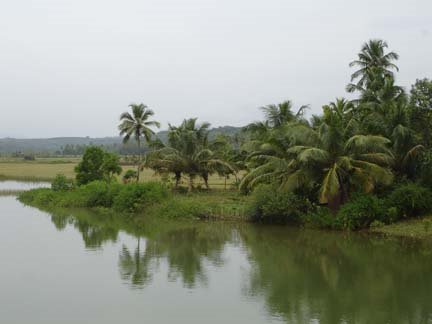Apart from the ancient spirit Gods like Kapri and Kuti, we discussed in previous post, there were lesser known Spirit Gods in ancient Tulunadu like Kata and Kandiya. Ramappa Vormika, a traditional Shanobogue working in the Kundapur area during the British administration of Kanara territories in a report dating back to 1819 mentioned Kata and Kandiya forms of worship among the aboriginal tribes of Karavali.
Kata
Kata is a Spirit God worshipped since antiquity by Koraga tribes of Tulunadu. Like most of the primitive Spirit Gods of this land, Kata is represented by a simple piece of stone, placed usually on a pedestal, under a tree. The Koraga word 'kata' has also found place in Tamil, wherein 'Katavul' means God.However, it seems the word is missing in modern Tulu.
Very little is known at present about the origin or evolution of the cult of Spirit known as Kata. The Koraga people also refer to 'marathadithaaye' (literally, the spirit under the tree). Places like Kata-pādi, spread in different parts of southern India,inclusive of Tulunadu, [example, (a) near Udupi and (b) near Chennai] could have been the ancient places dedicated to the cult of ancient Spirit God known as Kata.
Kandiya
The Spirit God Kandiya apparently was worshipped by ancient agricultural communities since the word ‘kanDa’ represents an agricultural land in Tulu. Kandiya is said to have been the Spirit God worshipped by non-Koraga communities.
The origin of the word ‘kanDa’ is interesting. The Munda word ‘kan+Da’ means good land. (Kan=good, Da=land, area). The word ‘kanDa’ has been adopted in Sanskrit as (1) a piece (of land) or (2) a continent.
Kandiya or Khandiya has evolved into several later forms like Kandevu and Khandoba. Ancient places of Khandiya worship were apparently known as Khandige. There are numerous places hamlets known as 'Kandige' in different parts of Tulunadu.
In northern Karnataka, Khandoba is popular as a Spirit God depicted astride on a horse like the Bermer Spirit of Tulunadu.
Kandevu appears to be the old name for places now usually referred to as Kandige or Khandige. Kandevu ancient spirit worship with passage of time has apparently been replaced by subsequent and current forms of worship.
Kandevi was a form of tribal language akin to Paisachi-Prakrit and it gradually evolved into present form of Konkani.
In northern Karnataka, Khandoba is popular as a Spirit God depicted astride on a horse like the Bermer Spirit of Tulunadu.
Kandevu appears to be the old name for places now usually referred to as Kandige or Khandige. Kandevu ancient spirit worship with passage of time has apparently been replaced by subsequent and current forms of worship.
Kandevi was a form of tribal language akin to Paisachi-Prakrit and it gradually evolved into present form of Konkani.
Kandiya was also the old name for a Greek port known presently as Heraklion. It was founded in the 9th century and was the capital of Crete until 1841.
®




